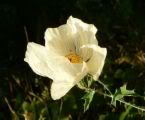

Scientific Name
Argemone albiflora ssp. texana
Uses of Bluestem Pricklypoppy: Landscaping, Medicinal, Culinary, etc...
The seeds of the white prickly poppy are said to be an excellent source of food for quail and other birds because of their high oil content. Additionally, the oil from the white prickly poppy was used as an alternative fine lubricant during WW II. Dr. Malcolm Gerngross, a researcher at Texas A&M College Station, found the oil content of white prickly poppy seed to be 25.8%, an amount comparable to that found in soybeans.
The white prickly poppy can be used as an ornamental. Its showy flowers make it an interesting addition to a native garden. It can also be used as a cut flower, and will last longer if the cut stem is seared over an open flame immediately after cutting.
General Characteristics
White prickly poppy (Argemone albiflora spp. texana) is an erect, prickly, deep-rooted, annual or biennial that contains bright yellow latex. A member of the poppy (papaveraceae) family, it has a showy white flower, with numerous yellow or reddish stamens. The sepals of the white prickly poppy are topped with sharp prickles, and the sepals fall off as the flower expands.
The leaves also are spiny, which keeps cattle from eating it, since this plant is somewhat poisonous. One researcher noted that the leaves of the white prickly poppy are so prickly that cattle will not even eat it during severe drought periods.
A related species, rose or spiny prickly poppy (Argemone sanguinea), has white, lavender, or purple flowers. It can be found in the southern half of Texas, from the coast, to the far western border of the state. White prickly poppy has ascending prickles on its sepals, as opposed to the perpendicular prickles on the sepals of the rose prickly poppy.
Required Growing Conditions
White prickly poppy can be found from northern Arkansas and southern Missouri to Texas. In Texas, it can be found in all regions except the panhandle and far western portions of the state. White prickly poppy tends to grow best in sandy or gravelly soils, although it has been grown successfully in clayey soils at the Kika de la Garza Plant Materials Center. It is often found in disturbed areas, along fence rows and railroad tracks, on hills and slope and in overgrazed pastures and old fields. White prickly poppies tend to grow in colonies.
Cultivation and Care
White prickly poppy is best grown from seed. The fairly large seeds make it a good candidate for direct seeding methods. White prickly poppy has been successfully seeded at the Plant Materials Center. It can be drilled or broadcast in rows, strips, or small patches to create food plots for birds. Broadcast at 3 lbs. of pure live seed per acre, or drill at 1 lb. of pure live seed per acre. There are approximately 157,600 seeds per pound. Seeds should be sown in the late fall.When germination was tested on two occasions at the Plant Materials Center, seed viability tended to vary widely. In 1994, germination percentages ranging from 0 to 76 percent were found for 43 different accessions of white prickly poppy. Average germination for this study was 12 percent. Temperatures for the 1994 germination tests were10º C for 12 hours of darkness and 25º C for 12 hours of light. A 1999 study using a twelve accession composite seed source yielded germination ranging from 10 to 22 percent, with an average germination of 17 percent. Temperatures for this study were 10º C for 12 hours of darkness 25º C for 12 hours of light.
General Upkeep and Control
Once white prickly poppy has been established, the plot should be disked annually to control competition and to replant seeds. For seed production purposes, seed can be harvested with a combine when the tip of the seed capsule begins to turn brown. If you wait too long to harvest, seed shatter will occur. Under dryland conditions at the Plant Materials Center, white prickly poppy produces approximately 130 lbs of seed per acre.





0 comments: